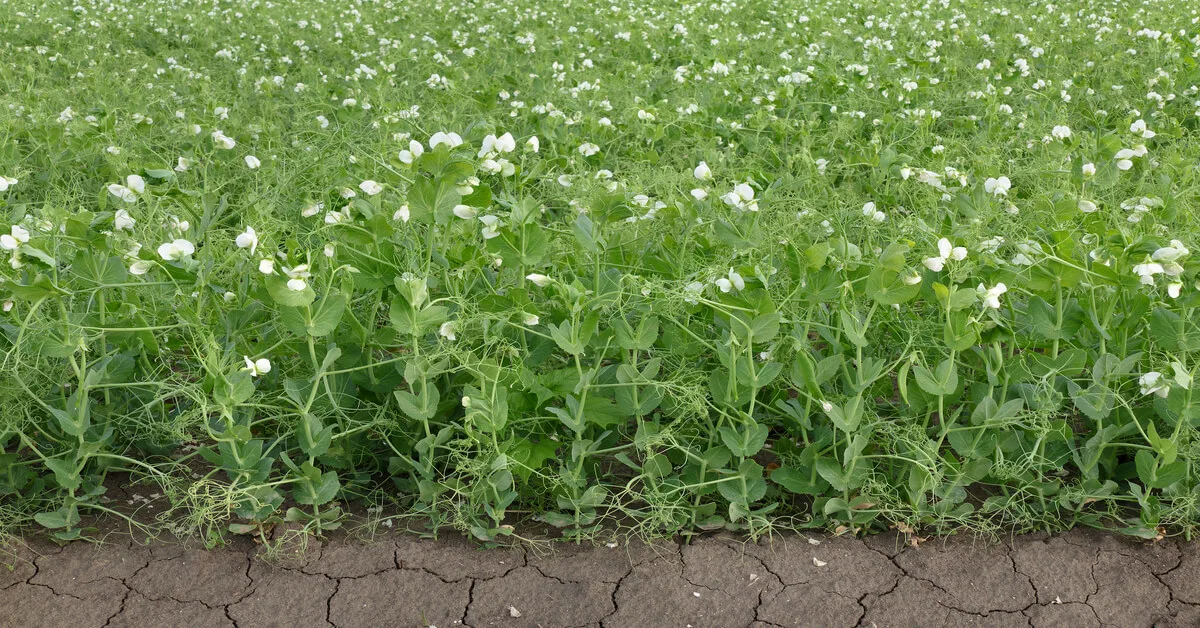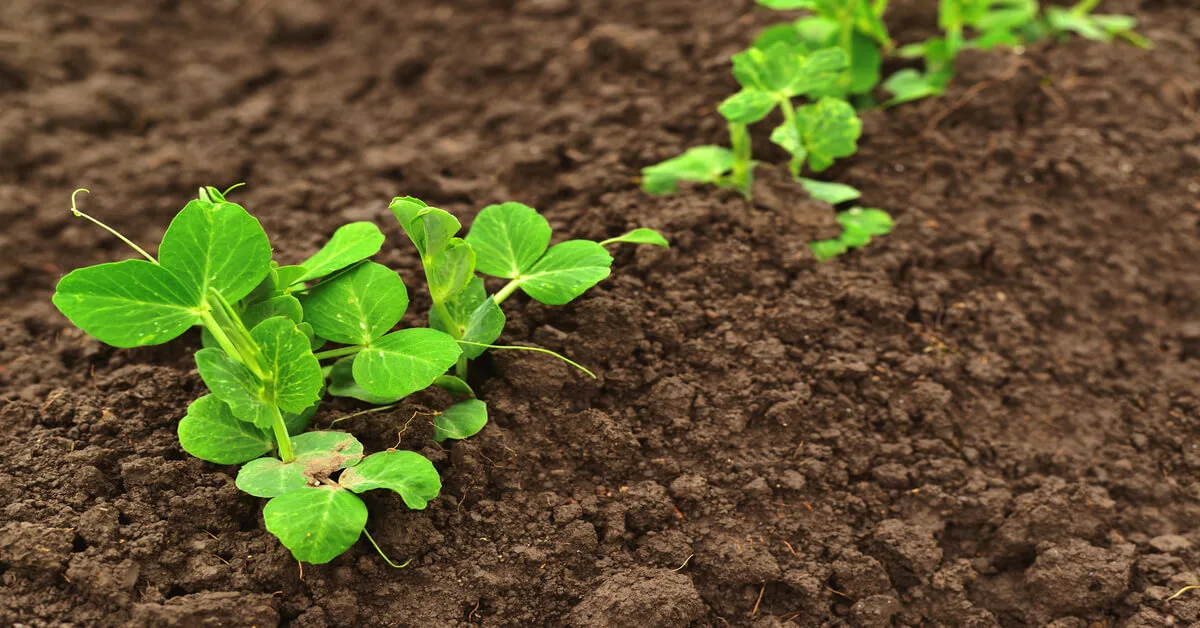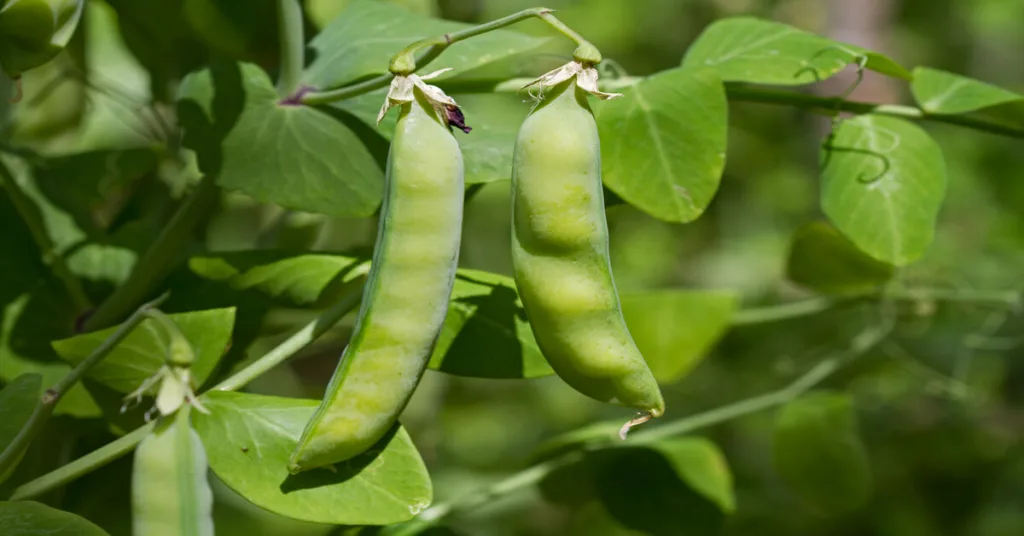Peas (Pisum sativum) are easy to plant, grow, and harvest and will reward you with a bountiful crop in about two months. They must be grown in early spring since they stop growing when temperatures are above 85 degrees Fahrenheit. They are low-maintenance vegetables that simply need plenty of direct sunlight and rarely need water unless there’s a drought.
Evidence of peas being harvested for human consumption dates back to 4800 B.C. They’re native to the Mediterranean Basin and a few parts of the Near East. In the middle ages, dry peas were often grown and used to prevent famine. There is no record of a distinction between garden peas and field peas until the early 17th century.
In this article, we’ll tell you everything you need to know to successfully plant, grow, and harvest peas in your garden.
Pea Plant Care

Pea plant care is relatively easy and doesn’t require much time or effort. You’ll likely spend more time harvesting the pods than you will growing them.
The main requirements are full sun and a trellis for them to grow on. Rainfall typically provides enough water since they only need enough water to soak the top inch of soil once a week. Choose a disease-resistant variety so you don’t have to worry about disease issues.
Below are all of the details regarding how to care for pea plants.
Soil
Peas can grow in sandy to clayey soil as long as it is well-drained and has a pH of 6 to 7.5. Consider adding 3 to 4 inches of mulch to help retain soil moisture and reduce weeds.
Watering
Since peas are grown before the heat of summer, they may not need to be watered unless it doesn’t rain. They should get enough water to soak the top 1 inch of soil once a week for good growth and pod development.
Lighting
Peas need 6 to 8 hours of direct sunlight for optimal growth. Less light will cause them to grow slower and produce fewer pods.
Humidity & Temperature
High humidity will increase the chances of disease issues in peas. Soil temperatures need to be at least 40 degrees Fahrenheit for seeds to germinate. If a late frost kills newly emerged plants, they will resprout as long as no more than 6 leaf nodes developed. Peas will stop growing and producing pods when temperatures rise above 65 degrees Fahrenheit.
Fertilizing
Soil testing is the best way to determine if you need to add compost or fertilizer to the soil. Fertilizer should be added before planting seeds. Most peas will grow normally without adding fertilizer.
Diseases & Pests
Diseases of pea plants include root rot, brown spot, downy mildew, gray mold, powdery mildew, Rhizoctonia, Septoria blotch, bacterial blight, pea enation mosaic virus (PEMV), and red clover vein mosaic virus (RCVMV). There are many disease-resistant varieties that can be planted to avoid disease issues.
Insects that feed on pea plants include aphids, leaf miners, Mexican bean beetles, thrips, nematodes, and mites. Detecting insect issues early will make them easier to get rid of.
Days to maturity
Depending on the type and variety of pea, it takes about 60 to 80 days to reach maturity. Colder temperatures cause plants to mature slower.
Harvesting

Once the first pod is ready for harvest, you’ll need to check and harvest newly ripened pods daily. They will over-ripen in a matter of days if left on the plant.
Harvested peas can be eaten fresh for 1 to 3 days before the sugars start to break down and pods become unpalatable. To make them last longer, blanch fresh peas and freeze them for later.
To harvest dried peas, allow them to remain on the plant until they’re dried and begin to turn brown. Pull the entire plant from the ground and store them in a cool dry place upside down to finish drying completely. Remove peas from the pods and store them in an air-tight container.
Pea Plant Life Cycle
Emergence (0-14 days): Pea emergence time is significantly impacted by soil temperature. At 60 degrees Fahrenheit, they emerge in about 7 days. At lower temperatures, they can take up to 30 days to emerge.
Vegetative Growth (14-50 days): Pea plants will get taller and put on leaves for an average of 35 days after emergence. At lower temperatures and depending on the species, the vegetative growth stage may last longer.
Flowering Stage (40-80+ days): Once plants have enough leaves, they will begin to produce flowers. Flowers will continue to emerge for an average of 4 weeks depending on the variety and temperatures.
Fruiting and Ripening Stage (47-55+ days): Once a flower opens, it takes about 20 to 30 days for garden and field pea pods to develop and ripen. Sugar snap and snow peas only take about a week since they are harvested before the seeds fully develop in the pods.
Harvesting Stage (55+ days): Depending on the species and variety, peas are ready to harvest about 55 days after planting.
When & How to grow peas

Peas should be planted as soon as soil temperatures are above 40 degrees Fahrenheit. Don’t attempt to start them indoors. Peas rarely survive being transplanted due to their delicate root systems being easily damaged.
Supporting Pea Plants
Use a trellis to support both vining and bush type pea plants. You can make a trellis by placing two stakes on either end of the row and attaching string or netting between them. Plant vining types directly under the trellis and bush types several inches away from it.
Growing Peas From Seed
Place a trellis where you will plant your seeds. Seeds should be planted 1 inch deep. Leave 2 to 3 inches between vining type seeds and 6 to 7 inches between bush type seeds. Gently pat down the soil over the seeds.
Growing Peas Upside Down
You can grow pea plants upside down, though there have been mixed results with this method. You can either purchase or make your own upside-down planters which are easy to find since upside-down gardening has become more popular. Care for upside-down peas the same way you would container-grown peas, minus the need for staking or a trellis.
Growing Peas in Pots
Use pots that are at least 8 inches wide and 18 inches deep. Create a trellis using three stakes. Place the stakes in the soil around the edge of the pot making a triangle. Pull the stakes together at the top and secure them with a string, twist tie, or zip tie.
You can grow two to three vining pea plants in an 8-inch pot or a single bush type. It’s recommended that you plant a few extra seeds in case some don’t germinate. You can thin them out once they have two to three leaves and keep the healthiest-looking plants.
Types of Pea Plants
There are four types of peas you can grow, shelling, snow, sugar snap, or field peas. Shelling peas are the most common garden type and are also called ‘garden peas’ or ‘English peas’. They are harvested when the seeds are fully matured and are removed from the pods which aren’t eaten.
Snow peas and sugar snap peas are harvested before the seeds are fully matured and the pods are still soft and edible. Snow peas have thin pods that are flatter and are harvested when the peas are small and just starting to develop. Sugar snap peas are harvested when the seeds are almost fully matured but the plump pods are still soft.
Field peas have a lower sugar content and more of a typical bean flavor than other peas. They are also called ‘cowpeas’ or ‘Southern peas’. Black eye peas are a type of field pea but there are tons of other varieties. Field peas are typically sold as dried, shelled peas.
Below is a table comparing a few of the most popular pea varieties of all four pea types.
| Name | Type | Characteristics | Days to Maturity |
| Garden Sweet | Garden pea | Extra sweet peas, 3.5 inch long pods contain 9 to 10 peas | 75 |
| Mr. Big | Garden pea | Moderately sweet, pods contain 9 to 10 extra large peas | 60 |
| Wando | Garden pea | Moderately sweet, 7 to 8 peas per pod, great for drying or freezing, easily grown in cold or warm climates | 70 |
| Avalanche | Snow pea | Sweet and tender, 6 inch long dark green pods, disease resistant | 60 |
| Oregon Sugar Pods | Snow pea | Very sweet and tender, 4.5 inch pods, disease resistant | 70 |
| Snowbird | Snow pea | Moderately sweet, 3 inch pods, pods set in groups of 2 or 3 | 60 |
| Sugar Ann | Sugar snap pea | Sweet and crisp, 7 peas per pod, disease resistant | 55 |
| Sugar Bon | Sugar snap pea | Very sweet, 3 inch pods, disease resistant | 55 |
| Sugar Snap | Sugar snap pea | Very sweet, 3 inch pods | 60 |
| California Blackeye Pea | Field pea | 6 to 8 inch pods, tan pea with single black spot, heat tolerant | 70 |
| Red Ripper Pea | Field pea | 12 to 14 inch pods, dark reddish brown pea | 70 |
| Zipper Cream Pea | Field pea | 9 inch pods, cream to light green pea, easy to shell | 65 |
Pea Companion Plants
Companion plants are grown together to benefit one or both plants in the garden. There are several benefits they can provide one another which include:
- Improving overall plant health
- Improve yield
- Improve germination
- Improving taste
- Repel or trap undesirable insect pests
- Attract pollinators
- Weed management
- Increase space efficiency
Peas are nitrogen fixers meaning they can pull nitrogen from the air and ‘fix’ it into the soil. This can be extremely beneficial for many plants and reduce the need for adding fertilizer to your garden. Reducing fertilizer inputs saves you money and reduces the environmental impacts of fertilizer runoff into waterways. Companion plants that benefit from nitrogen produced by peas include lettuce, peppers, sweet corn, and winter wheat[2].
Peas can have issues with weeds due to their growth habit. Most grow upward as vines on trellises which leaves plenty of exposed soil for weeds to germinate in. Planting peas with peppers can reduce weed growth and help reduce or eliminate the need for herbicide applications.
Cowpeas can be planted with tomatoes to reduce insect damage on tomato plants. Stink bugs prefer to feed on cowpeas and will readily feed on them instead of tomatoes.
There are many companion plants you can use to optimize the space in your garden when growing peas. Carrots, celery, eggplant, radish, spinach, and turnips can all be grown alongside peas without either plant competing with one another for resources.
Pea Benefits
Peas have numerous health benefits due to their nutrient content. They contain coumestrol which can reduce colon cancer risks[1]. Omega 3 and 6 found in peas can reduce plaque buildup in blood vessels which improves heart health[1].
Anti-inflammatory nutrients found in peas such as caffeic acid, catechin, epicatechin, ferulic, and vitamins A and B can help lower the risk of diabetes, arthritis, and heart disease[3]. They also contain antioxidants such as catechin, epicatechin, vitamins C and E, and zinc which can boost the immune system[3]. The protein and fiber in peas can help regulate blood sugar[3].
They also benefit the soil by fixing nitrogen which reduces the need to apply fertilizer.
Peas vs Beans
The main difference between peas and beans is the shape and color of their pods. Peas are generally more cylindrical while beans can be a variety of shapes. Peas are almost always green while beans can be green, yellow, or purple and have a variety of patterns.
While peas also have hollow stems while bean stems are solid on the inside. Beans can tolerate hot summer weather and can survive frost while peas are the opposite. Beans also last longer after harvesting than peas.
References:
[1] Burrow, R. (2019). Garden Peas. South Dakota State University Extension.
[2] Nations, C. & Mah, M. (2022). Better Together: The New Science of “Companion Planting”. University of California Agriculture and Natural Resources.
[3] Web MD Editorial Contributors. (2022). Health Benefits of Peas. Web MD.

